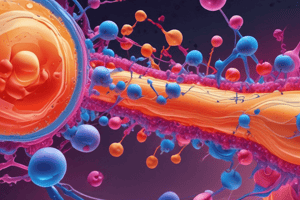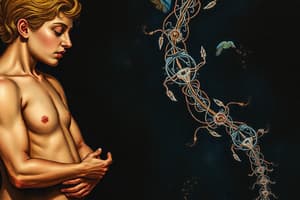Podcast
Questions and Answers
What is the role of insulin in the human body?
What is the role of insulin in the human body?
Insulin is a hormone that regulates blood sugar levels by promoting the uptake of glucose from the bloodstream into cells for energy or storage. It also helps regulate metabolism by promoting the storage of carbohydrates and lipids and the synthesis of proteins.
Where is insulin produced and secreted?
Where is insulin produced and secreted?
Insulin is produced and secreted by beta cells in the pancreatic islets of Langerhans.
Which of the following is NOT a major step in the biosynthesis of insulin?
Which of the following is NOT a major step in the biosynthesis of insulin?
- Conversion of proinsulin to insulin
- Synthesis of preproinsulin
- Conversion of preproinsulin to proinsulin
- Conversion of insulin to glucagon (correct)
Which form of insulin is typically stored in the pancreas and released slowly into the bloodstream?
Which form of insulin is typically stored in the pancreas and released slowly into the bloodstream?
Insulin lispro (recombinant analog) is a modified form of insulin designed to increase the formation of dimers and hexamers, thus providing a longer-acting effect.
Insulin lispro (recombinant analog) is a modified form of insulin designed to increase the formation of dimers and hexamers, thus providing a longer-acting effect.
Glucokinase, a key enzyme in glucose sensing in pancreatic beta cells, has a high affinity for glucose, allowing it to efficiently utilize glucose even at low levels.
Glucokinase, a key enzyme in glucose sensing in pancreatic beta cells, has a high affinity for glucose, allowing it to efficiently utilize glucose even at low levels.
Describe the role of the ATP-dependent potassium channel (KATP) in regulating insulin secretion.
Describe the role of the ATP-dependent potassium channel (KATP) in regulating insulin secretion.
Which signaling pathway is primarily involved in promoting cellular growth and proliferation in response to insulin?
Which signaling pathway is primarily involved in promoting cellular growth and proliferation in response to insulin?
What is the major mechanism by which insulin promotes glucose uptake in target cells?
What is the major mechanism by which insulin promotes glucose uptake in target cells?
Describe the two main types of diabetes mellitus.
Describe the two main types of diabetes mellitus.
An insulinoma is a tumor that develops in the insulin-producing beta cells of the pancreas and is often characterized by hyperglycemia and diabetic ketoacidosis.
An insulinoma is a tumor that develops in the insulin-producing beta cells of the pancreas and is often characterized by hyperglycemia and diabetic ketoacidosis.
Explain the difference between hypoglycemia and hyperglycemia.
Explain the difference between hypoglycemia and hyperglycemia.
Flashcards
Insulin
Insulin
A peptide hormone secreted by pancreatic beta cells that lowers blood glucose and promotes anabolism, essential for normal development.
Pancreatic Islets of Langerhans
Pancreatic Islets of Langerhans
Clusters of cells in the pancreas that secrete insulin.
Insulin History
Insulin History
Early discoveries (Langerhans 1869, Minkowski & von Mering 1889) led to Banting's 1921 isolation and subsequent Nobel Prize-winning work, emphasizing its role in managing diabetes.
Insulin Structure
Insulin Structure
Signup and view all the flashcards
Insulin Forms
Insulin Forms
Signup and view all the flashcards
Insulin Receptor interaction
Insulin Receptor interaction
Signup and view all the flashcards
Insulin lispro
Insulin lispro
Signup and view all the flashcards
Study Notes
Membrane Biochemistry (Bio-4117) Lecture 3, Level 4
- Course Instructor: Dr. Mariam Osama
- Email: [email protected]
- Office: 236 Biotechnology
- Office Hours: Wednesdays 2:00 PM - 4:00 PM
Mechanism of Action of Insulin
- Diagram of Insulin molecule structure shown.
Outline
- Introduction to Insulin
- History
- Structure of Insulin
- Biosynthesis of Insulin
- Degradation of Insulin
- Regulation of Insulin Secretion
- Biological Actions
- Effect on Carbohydrate, Lipid, and Protein Metabolism
- Insulin Receptor
- Mechanism of Action
- Insulin Signaling Pathways
- Disorders
Introduction
- Insulin is a peptide hormone secreted by beta cells in the pancreatic islets of Langerhans.
- Its main function is to lower serum glucose and promote anabolism.
- It's an essential growth factor for normal development.
History of Insulin
- 1869: Paul Langerhans noted pancreatic islets.
- 1889: Minkowski and von Mering observed diabetes in pancreatectomized animals.
- 1920: Frederick Banting isolated insulin from pancreatic islets.
- 1923: Banting and Macleod received Nobel Prize for insulin discovery.
- 1955: Frederick Sanger determined the primary amino acid sequence of insulin.
- 1958: Sanger received Nobel Prize in Chemistry for insulin sequencing.
- 1964: Dorothy Hodgkin won Nobel Prize in Chemistry for protein crystallography.
- 1978: Genentech produced synthetic human insulin using recombinant DNA technology.
Insulin Structure and Forms
- Human insulin is composed of 51 amino acids with a molecular weight of 5.7 kDa.
- Two polypeptide chains (A and B) linked by disulfide bridges.
- Three intra-chain disulfide bridges (in A chain) and two inter-chain disulfide bridges.
- Exists as a monomer, dimer, or hexamer depending on concentration.
- Monomer: rapidly absorbed.
- Hexamer: slower absorption.
- Dimer: intermediate form
Insulin Lispro (Recombinant Analog)
- Insulin lispro is a modified form of insulin.
- The lysine and proline amino acid residues in B chain C-terminus are reversed.
- The change makes it to form fewer dimers and hexamers, leading to faster absorption in bloodstream.
Biosynthesis of Insulin
- Synthesized by ribosomes in the rough endoplasmic reticulum (ER) as preproinsulin.
- Preproinsulin undergoes cleavage to proinsulin.
- Proinsulin is further cleaved to form mature insulin.
- C-peptide is a byproduct of insulin formation.
Conversion of Proinsulin to Insulin
- Proinsulin undergoes conversion to active insulin via prohormone convertases (PC1 and PC2) and carboxypeptidase E.
- C-peptide is released, leaving A and B chains linked by disulfide bonds.
- Insulin folds into a hexameric form (with zinc) in secretory granules.
Regulation of Insulin Secretion by Glucose in Pancreatic β-Cells
- Glucose enters β cell via GLUT2 transporter and is phosphorylated by glucokinase.
- Increased ATP/ADP ratio closes ATP-sensitive K+ channels, causing depolarization.
- Depolarization opens voltage-gated Ca2+ channels allowing calcium influx.
- Calcium triggers insulin secretion via exocytosis from granules.
Insulin Action on Carbohydrate Metabolism
- Liver: stimulates glycolysis; promotes glycogen storage; inhibits glycogenolysis and gluconeogenesis.
- Muscle: stimulates glucose uptake; promotes glycogen storage
- Adipose Tissue: stimulates glucose transport into adipocytes; promotes conversion of glucose to triglycerides and fatty acids.
Insulin Receptor and Mechanism of Signaling
- Insulin receptor: receptor tyrosine kinase
- extracellular alpha subunit (ligand binding).
- transmembrane beta subunit (tyrosine kinase activity).
- The functional receptor exists as a dimer composed of two alpha and two beta subunits ( α2β2).
- Signal transduction:
- Insulin binds to the alpha subunit causing dimerization.
- This activates the beta subunits' tyrosine kinase activity.
- Autophosphorylation occurs on tyrosine residues.
- Ras-dependent and Ras-independent pathways activate.
Ras-Independent Pathway (PI3K/Akt Signaling)
- Insulin binding to the receptor leads to a conformational change.
- IRS proteins are phosphorylated.
- PI3K is activated, resulting in the formation of phosphoinositides.
- Akt (protein kinase B) is recruited to the membrane.
- Akt is activated via phosphorylation.
- GLUT-4 translocation to the cell surface, leading to increased glucose uptake.
- Inhibition of glycogen synthase kinase 3 (GSK3).
Ras-Dependent Pathway (Shc/RAS/MAPK Signaling)
- Insulin activates Shc.
- Shc activates Grb2, which activates Sos.
- Sos activates Ras.
- Ras activates Raf.
- Raf activates MEK.
- MEK activates ERK.
- ERK enters the nucleus and activates transcription factors, leading to cellular responses.
GLUT-4 Translocation
- GLUT4 is stored intracellularly in vesicles in resting state.
- Insulin stimulates GLUT4 translocation to cell membrane.
- GLUT4 translocation is crucial for glucose uptake.
- PI-3K/Akt pathway plays a key role in this process.
Degradation of Insulin
- Insulin has a short half-life (4-6 minutes).
- Liver is the primary site of insulin degradation.
- Hepatic glutathione insulin transhydrogenase reduces disulfide bonds, separating A and B chains.
- Insulin degrading enzyme (IDE) cleaves the B chain to smaller fragments.
Diabetes Mellitus
- A group of metabolic diseases characterized by elevated blood glucose levels (hyperglycemia).
- Defects in insulin secretion, insulin action, or both.
- Type 1 Diabetes: autoimmune destruction of insulin-producing beta cells in pancreas.
- Type 2 Diabetes: defects in insulin action or secretion.
- Gestational Diabetes: occurs during pregnancy.
- Pre-diabetes: elevated blood glucose but not high enough to be diagnosed diabetes.
High Insulin Level (Insulinoma)
- Adenoma of islets in pancreas.
- Increased insulin secretion.
- Neuropsychiatric symptoms: nervousness, confusion, hypoglycemic attacks.
Insulin Shock
- High level of insulin, fall in blood glucose, CNS depression.
- Symptoms depend on blood glucose levels, ranging from CNS excitability to coma.
What We Have Learned
- Insulin's effects (metabolic and mitogenic responses) depend on its signaling pathway.
- Signaling involves the insulin receptor, IRS proteins, PI3K, and Akt.
- Degradation of insulin involves hepatic enzymes and protein digestion.
Studying That Suits You
Use AI to generate personalized quizzes and flashcards to suit your learning preferences.




